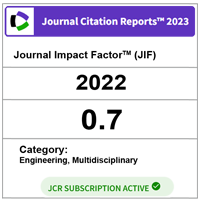MONITORING RUBBER FACTORY MALODOUR USING ARTIFICIAL NEURAL NETWORK
DOI:
https://doi.org/10.11113/jt.v77.6775Keywords:
Rubber factory malodour, electronic nose, artificial neural network, real time monitoringAbstract
Malodour from rubber factory activities is a nuisance to the residence in the surrounding area. The volatile chemical compounds emitted from the factory are identified as the major source of the malodour. This research proposes a study of malodour monitoring for the rubber factory using Electronic Nose (e-nose) system to enable effective malodour monitoring. The proposed system will able to predict and monitor the malodour concentration in the surrounding area of the factory. The finding will be used as a guideline for monitoring the violations of environmental guidelines. The malodour and environment parameters such as temperature, wind speeds and directions are recorded. These parameters are measured on-site and monitored using wireless sensor network (WSN) system. The malodour concentration model of each location will generate using three types of Artificial Neural Network (ANN) i.e. Multilayer Perceptron (MLP), Radial Basis Function (RBF) and Probabilistic Neural Network (PNN). These indices will be used to generate the malodour concentration mapping model of the factory and surrounding areas. The initial results show that the system can be effectively used for real time rubber factory malodour monitoring.
References
Leksmono, N. S., Longhurst, J. W. S., Ling, K. A., Chatterton, T. J., Fisher, B. E. A. and Irwin, J. G. 2006. Assessment of the Relationship Between Industrial and Traffic Sources Contributing to Air Quality Objective Exceedences: A Theoretical Modeling Exercise. Enviromental Modelling & Software. 21: 494-500.
Mallet, V. and B. Sportisse. 2008. Air Quality Modeling: From Deterministic to Stochastic Approaches. Computers & Mathematics with Applications. 55: 2329-2337.
Bert Brunekreef S. and Holgate, S. T. 2002. Air Pollution and Health. The Lancet. 360: 1233-1242.
Collet, R. and Oduyemi, K. 2006. Air Quality Modelling: A Technical Review of Mathematical Approaches. Meteorological Applications. 4(3): 235-246.
Shi, J. and Harrison, R. 1997. Regression Modeling of Hourly NOx and NO2 Concentrations in Urban Air in London. Atmospheric Environment. 31(24): 4081-4094.
Tekasakul, P. and Tekasakul, S. 2006. Environmental Problems Related to Natural Rubber Production in Thailand. Journal of Aerosol Research. 21(2): 122-129.
Thongpradistha, J. 1999. Isolation, Identification, and Cultivation of Photosysthetic Bacteria in Wastewater from Concentrated Latex Processing Factory. Thesis, Prince of Songkla University, Thailand.
Leffingwell, J. C. 2002. Olfaction: A Review-Update No.5. Leffingwell Reports. 2(1): 1-34.
Mahmoudi, E. 2009. Electronic Nose Technology and Its Applications. Sensor and Transducers Journal. 107(8): 17-25.
Pearce, T. C., Schiffman, S. S., Nagle, H. T. and Gardner, J. W. 2003. Handbook of Machine Olfaction: Electronic Nose Technology. Verlag: Wiley-VCH.
Amamcharla, J. 2008. Artificial Olfactory Sensing Systems for Safety Assessment of Packaged Beef. Phd Thesis in Agriculture and Applied Science. North Dakota State University, USA.
Weimar, U. 2003. Added Values of Chemical Sensors in Electronic Nose. Second Workshop of the Second Network on Artificial Olfactory Sensing (NOSE II). Linköping, Sweden.
Schaller, E., Bosset, J. O. and Escher, F. 1998. Electronic Noses and Their Application to Food. Lebensmittel-Wissenschaft and Technologie. 31: 305-316.
El Barbri, N., Amari, A., Vinaixa, M., Bouchikhi, B., Correig, X. and Llobet, E. 2007. Building of a Metal Oxide Gas Sensor-Based Electronic Nose to Assess the Freshness of Sardines Under Cold Storage. Sensor Actuator B: Chemistry. 128: 235-244.
Gardner, J. W. and Bartlett, P. N. 1994. A Brief History of Electronic Noses. Sensor and Actuators B. 18-19: 211-220.
Arshak, K., Lyons, G.M., Cunniffe, C., Harris, J. and Clifford, S. 2003. A Review of Digital Data Acquisition Hardware and Software for a Portable Electronic Nose. Sensor Review. 23(4): 332-344.
Li, C.H. 2006. Sensor Fusion Models to Integrate Electronic Nose and Surface Acoustic Wave Sensor for Apple Quality Evaluation. Phd Thesis in Agricultural and Biological Engineering. Penn. State University, USA.
Marini, F. 2009. Artificial Neural Networks In Food Product Analyses: Trends and Perspectives: A Review. Analytica Chimica Acta. 635(2): 121-131.
Svozil, D., Kvasnicka, V. and Pospichal, J. 1997. Introduction to Multi-Layer Feed-forward Neural Networks. Chemometrics and Intelligent Laboratory Systems. 39: 43-62.
Specht, D. F. 1990. Probabilistic Neural Networks. Journal of Neural Network. 3(1): 109-118.
Downloads
Published
Issue
Section
License
Copyright of articles that appear in Jurnal Teknologi belongs exclusively to Penerbit Universiti Teknologi Malaysia (Penerbit UTM Press). This copyright covers the rights to reproduce the article, including reprints, electronic reproductions, or any other reproductions of similar nature.





